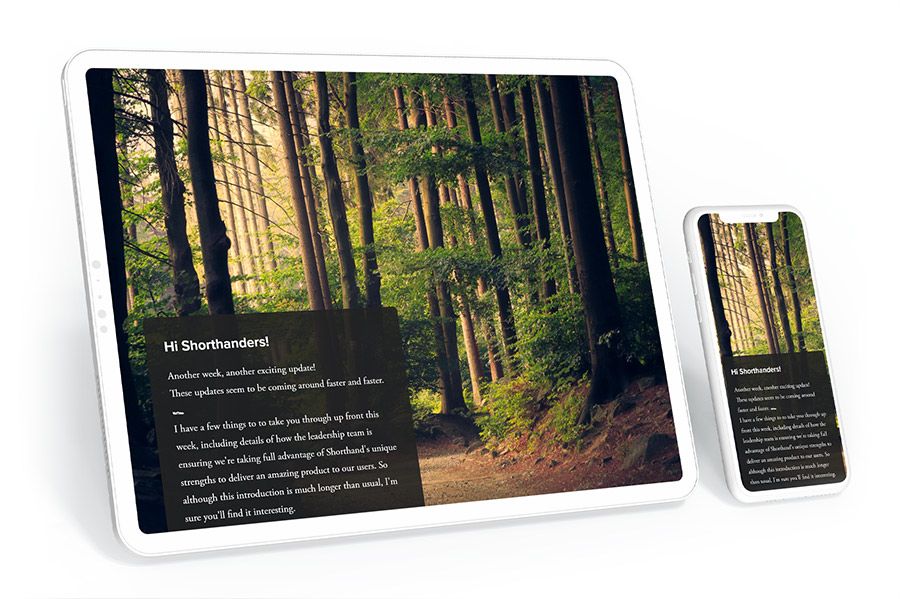11 tips for effective internal communications

We're currently in the middle of an internal communications crisis. According to a Gallup 'State of the Workplace' report, only 15% of the world's world-force is 'engaged.' And this study was conducted prior to the rise of pandemic-driven remote work.
This is, on the macro level, a massive problem for global prosperity and wellbeing. But it is also a major problem for individual companies, who struggle to attract, retain, and get the most out of their team members.
The good news is that there are new communication tools and internal communications best practices that can help improve your frontline employee experience and their work environment — and that's where we'll focus in this guide.
In this guide, we're going to cover:
- Internal communications explained
- What's the problem with most internal communications?
- How is internal communications changing with remote work?
- The rise of immersive internal communications
- 11 tips for building and implementing an effective internal communications strategy
Without further ado, let's dive into our guide!
What do the BBC, Tripadvisor, and Penguin have in common?
They craft stunning, interactive web content with Shorthand. And so can you! Create your first story for free — no code or web design skills required.
Sign up now.
Internal communications explained
Internal communications is an umbrella term for all the bits of content — from emails and newsletters to onboarding for new employees, company policies, all-hands, and company 'town halls' — that the company provides to share information with team members.
Most of the time, internal comms is run by skilled human resources and communications professionals. Ideally, they set out a rigorous strategy and plan, with specific communication goals in mind.
The main point of your internal communications strategy is to unite every team member behind a series of company goals. Ideally, everyone should be able to see how their daily work contributes to the broader vision of the company.
This sounds simple, but it is incredibly difficult to get right. Generally speaking, the bigger the company, the more 'stuff' there is to communicate. And the more 'stuff' there is to communicate, the messier it gets — especially as communication channels, communications platforms, forums, and apps proliferate.
Larger companies also have more folks involved, and not all of these folks have the communication skills of your comms leaders.
On the other hand, by improving internal communications and uniting your team behind a common goal, you can boost employee engagement. And the benefits to higher employee engagement are massive, including:
Improved employee retention
Bored employees are twice as likely to leave a company. (Fun fact: only 12% of employees leave their jobs because they want more money.)
Improved productivity
It's generally accepted that high employee engagement correlates with improvements in productivity. According to Gallup, companies with engaged employees are 21% more profitable.
Internal champions for your company
As we've written elsewhere, the best champions for your company are your employees. An engaged workforce is much more likely to promote your to the networks, including on social media platforms like LinkedIn.
Despite these benefits, most internal communication isn't successful. To explain why, let's take a short trip down memory lane.
Learn more about using Shorthand's visual storytelling platform for internal communications.
The problem with most internal comms
Once upon a time, my inbox looked like this (warning: it's not pretty):


That's… a lot of email.
As well as these updates — all from different teams, with different tones, different messaging, different points of view, and different theories on English spelling and grammar — we had the company intranet. This had other company updates, usually from the corporate communications team.
The intranet was more coherent than my inbox, but was extremely painful to read. The intranet software looked like it had been designed in the mid-1990s — which was probably not far from the truth — and was very hard to use.
The screeds of top-down company news published there required enormous concentration to understand. Like the rest of my colleagues, I usually didn’t bother. This wasn't exactly stellar employee communication of company information.
Long story short: I didn’t know what the hell was going on. I didn’t know our company’s vision; I didn’t know of any wider goal my work was contributing to; I didn’t know what other teams were doing; and, ultimately, I didn’t feel any sense of loyalty to the organisation.
For me, the solution to this problem was simple.
I quit, and got a job elsewhere.
Want to learn more about internal marketing? Read our post on 8 proven internal marketing strategies.



Internal communications and remote workers

My story is hardly original — in fact, it’s more common than not in large organisations. And some of it is unavoidable. After all, not all CEOs take instruction from internal communicators and marketers! No doubt, good internal communication is difficult to achieve.
But the fact is, my company would never have treated its external stakeholders this way. The range of content marketers produced for customers — including case studies, educational material, collateral, videos, and public relations — was carefully produced to delight and engage.
It was clear, concise, and beautifully designed. This content was always much better than the comms destined for the internal audience.
Why is this a problem? There’s a cost to poor internal comms. It includes high turnover, poor engagement, low productivity, and — as word gets out — difficulty with recruitment.
You can read more about this in our guide to better internal marketing.
As more staff work remotely, this cost is higher than ever. To meet the challenge of remote work, we’ve seen the rapid uptake of many different comms and real-time internal communications tools, from Zoom to Slack. But these tools don’t fix poor internal communications — in fact, they can intensify problems that have already taken root.
Sustaining the morale and company culture of a distributed workforce requires more than a technological band-aid. So, how can companies create a culture of effective internal communication?



Immersive internal communications

Internal communications needs to be treated with the same kind of professionalism and strategic thinking as any customer-facing communications.
This was the approach taken by RELX, a FTSE 15 company with over 33,000 employees around the world.
In the past, staff at RELX may have been faced with many different email missives over the course of a single week. This meant that they missed out on some fantastic stories told by the RELX corporate communications team.
The solution? Internal communicators at RELX bundled all the updates from various internal communication channels into a single Friday newsletter. Instead of getting many different emails a week from the company, staff were now getting one.
The internal communicators on the corporate communications team were then able to focus on creating high quality, immersive visual stories for their more than 33,000 staff. These stories — including features on innovation, long-serving staff, and environmental initiatives — communicated the values and achievements of RELX.
And with their new distribution strategy, they were actually getting read.
The results? The regular publication of these stories correlated with an increase in RELX’s internal NPS of 20 percentage points.
Now let's turn to our 11 tips on how to create immersive stories for an internal audience — stories that will actually get read, and that can improve the morale, retention, and performance of your team.
1. Have an internal communications strategy
Internal comms are usually messy. Staff get emails from all directions. The bigger the company, the worse this problem can be — and the harder it can be to fix.
The best solution is to apply the same strategic rigour and planning to your internal comms as you would to your external marketing. Start with your business goals and business strategy, and then map out the workload and outputs of your corporate communications team, so that you can reliably sustain a regular publication schedule.
Once you have your strategy drafted, create a concrete internal communication plan and share it far and wide. Get employee feedback from other teams and senior managers. Ensure everyone is on the same page. This will make it much easier to rein in ‘cowboy comms’ from across the organisation further down the track.
At the end of the day, you should have an internal comms content calendar to rely on.
2. Profile your team
The most valuable part of your company is its people, who are always more interesting and weird (in a good way) than their job titles would suggest. Make it a priority to publish longform features on staff across the company. This is often the easiest and most effective way to raise company morale (and key metrics like staff Net Promoter Scores).
A great example comes from RELX (again). They’ve published a range of features on their staff, including this piece on long-serving staff members. This turned out to be one of the most popular stories they published — and led to higher than usual engagement.
As an aside, the best internal comms is actually two-way communications. As you profile your team, make sure you include their specific voice — and not just repurposed company messaging.
3. Show off your products or services
Most people who work at large organisations don’t fully understand the products and services their company provides.
Take the opportunity to regularly interview folks from the product team, and translate these interviews into feature stories for the wider company. Show off the creativity and innovation of your product team, and give staff another reason to feel proud of the company they work for.
This will help create a culture of internal champions for your company, making it more likely that they will speak positively about you on social networks like LinkedIn.
4. Introduce new policies
Large companies have a range of corporate policies — for good reason. These policies are often written in consultation with the legal team — also for good reason. But this can make them dull or difficult to understand, which can lead to HR problems down the line.
De-risk corporate policies by providing a visual, immersive, and human-readable introduction. This can help staff accept policies that might otherwise be misunderstood or ignored.
5. Communicate change
Organisational change — through corporate restructuring or strategic realignment — is the biggest challenge most corporate communications teams face. Content will only be one part of this business communications challenge, which inevitably involves many face-to-face (or Zoom video conferencing) meetings and calls.
The main role of content during organisational changes is to help staff understand the why. This question can be difficult for executives — who often communicate in rather bloodless terms (‘headcount,’ ‘synergies’) — to answer in plain English. This is where corporate communications teams can step in. Write an immersive feature story about the change, with illustrations, photos, and a friendly, common-sense overview of what’s taking place.
6. Celebrate accomplishments
Every company has its ups and downs — now more than ever. But within that macro story of a company’s share price, growth, or profitability is a multitude of small wins and accomplishments. Celebrate them, loudly and proudly. This will give you another chance to feature your key comms asset — the people in your company. Over time, these stories will contribute to a positive, celebratory internal culture, which will help make your company a great place to work.
7. Embody your culture
Corporate communications teams at large companies inevitably publish a lot of content. As part of your editorial workflow, make sure everything you publish embodies your company culture. Over time, consistency in tone and content will help make your official culture — the words on your ‘our culture’ webpage — something people actually live.
8. Report on social activities
Most companies, remote or in-person, have some kind of social calendar. Whatever these activities are — from work drinks and lunches to escape rooms and field trips — try to take photos and capture what went on. This will help put the people at your company front and center — again, your greatest communications asset.
9. Favour quality over quantity
Even the most engaged staff aren’t going to click on every link you send out. So when they do, make sure that every one of your stories is published to the highest standard possible.
Set the bar high. Your internal features should match the quality of stories published by major media companies, such as the BBC, NBC News, or Sky News.
Increasingly, large companies are utilising digital storytelling platforms to produce beautiful content with scroll-based animation effects. And they’re seeing great results, including increased pageviews, reduced bounce rates, and improved engagement.
10. Updates from the CEO
We’ve put this one quite far down the list — for a good reason.
CEOs are often focused — rightly — on the parts of the company that matter to the performance objectives of the CEO. This peek behind the curtain can be interesting to staff, but it can also be distracting or irrelevant to their day-to-day work.
The best CEO updates are calm and objective reports on the performance of the company, with a friendly and upbeat tone. Some CEOs opt for personal updates, but these should be done carefully. Photos from the CEO’s yacht or beach house might not have a desirable effect on a workforce at the best of times, let alone one experiencing furloughs or restructures.
Recently, Shorthand’s CEO, Ricky Robinson, began producing his weekly updates as an immersive feature story. Better than an email or blog post on a legacy CMS, the updates are beautiful to look at, concise, and uplifting. (I’ll take that raise now, Ricky).
11. Stay positive
As a general rule, make sure the tone of your internal communications is extremely positive. If there are problems that senior management want to deal with, the dreaded company-wide email is not the way to address them, and it will generally cause more problems than it solves. (Worst case scenario, the email will leak, and may even end up in the news.)
Great corporate communications present an opportunity to improve the culture and, ultimately, the performance of your company. They can improve productivity and retention, and make it easier to recruit new talent. For large companies, they’re just as important as the marketing content produced for an external audience.
With this in mind, some companies are producing immersive feature stories that mirror the production values and impact of stories produced by leading media companies. And, like RELX, they’re seeing great results.

